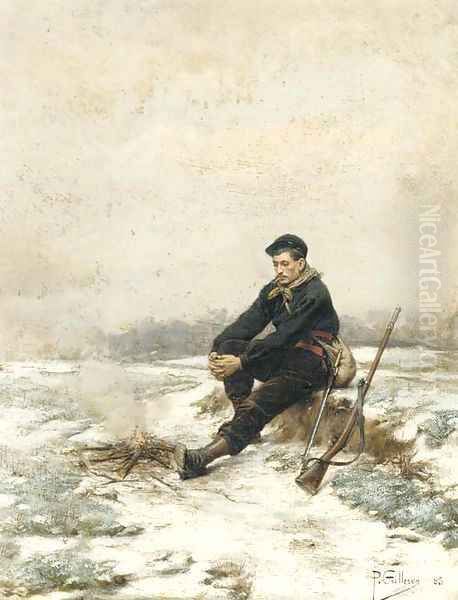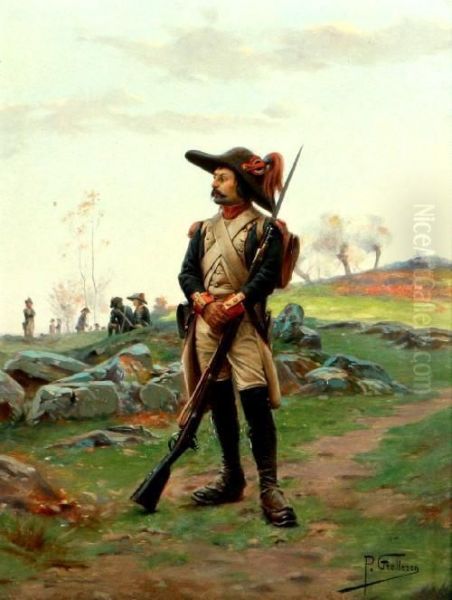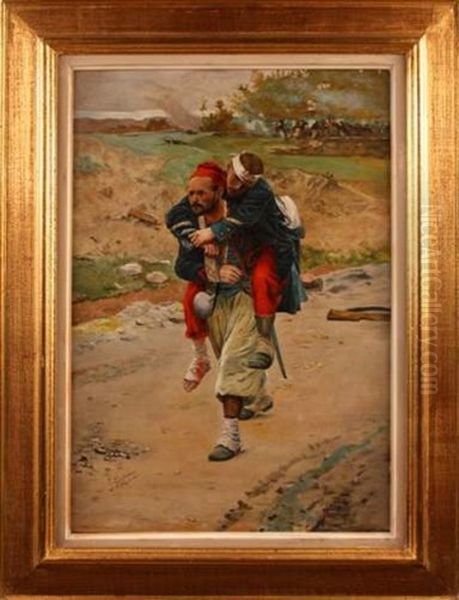Paul Louis Narcisse Grolleron (1848-1901) was a distinguished French painter and illustrator, primarily celebrated for his evocative and detailed depictions of military life, with a particular focus on the Franco-Prussian War. His work captured not only the grand theatre of conflict but also the intimate, human moments experienced by soldiers. Working within the academic tradition, Grolleron carved a niche for himself as a sensitive observer and skilled renderer of the French military experience in the latter half of the 19th century.
Early Life and Artistic Awakening
Born in 1848 in Seignelay, a commune in the Yonne department of Burgundy, France, Paul Louis Narcisse Grolleron's early life, like that of many artists of his generation, is not extensively documented in terms of familial artistic leanings. It is known, however, that his initial vocational aspirations were geared towards the decorative arts. This field, requiring a keen eye for detail, composition, and craftsmanship, likely provided a solid foundation for his later, more focused artistic pursuits.
The allure of Paris, the undisputed art capital of the 19th century, eventually drew Grolleron to the city. It was here that his artistic trajectory took a decisive turn. He sought and gained tutelage under Léon Bonnat (1833-1922), a highly respected and influential figure in the French academic art world. Bonnat, known for his powerful portraits of contemporary luminaries and his religious and historical paintings, was a staunch advocate of rigorous draftsmanship and a thorough understanding of anatomy and form. His atelier was a training ground for many aspiring artists, and under his guidance, Grolleron would have honed his technical skills, absorbing the principles of academic realism that would define much of his career.
A Shift in Focus: The Military Genre
While Bonnat's influence was significant, Grolleron's artistic passion found its most potent expression in the military genre. He began exhibiting his works at the prestigious Paris Salon from 1873 onwards. The Salon was the official, state-sponsored art exhibition and the primary venue for artists to gain recognition, attract patrons, and establish their reputations. Grolleron's decision to specialize in military subjects was timely and resonated with the French national psyche.

The Franco-Prussian War of 1870-1871, a conflict that resulted in a swift and humiliating defeat for France, the fall of the Second Empire, and the loss of Alsace-Lorraine, left an indelible mark on the nation. This period saw a surge in art that explored themes of patriotism, heroism, loss, and the daily life of the soldier. Grolleron's work tapped into this collective consciousness, offering depictions that ranged from the dramatic intensity of battle to the quieter, more reflective moments of military life. He became particularly known for his portrayals of individual soldiers or small groups, often emphasizing their humanity and the anecdotal aspects of their experiences.
Artistic Style and Thematic Concerns
Grolleron's artistic style was characterized by its meticulous detail, strong narrative quality, and empathetic portrayal of his subjects. Trained in the academic tradition, his paintings exhibit a high degree of finish, with careful attention paid to the accurate rendering of uniforms, weaponry, and the settings in which his figures were placed. His brushwork was generally precise, allowing for a clear and legible depiction of his chosen scenes.
His thematic concerns were varied within the military genre. While he did paint combat scenes, such as the generically titled but representative Combat Scene of 1870, he was perhaps more renowned for his depictions of soldiers during moments of respite, camaraderie, or solitary duty. Works like Soldier at Rest exemplify this aspect of his oeuvre, showcasing a soldier in a moment of quiet contemplation, perhaps after a march or a skirmish. These paintings often highlight the everyday realities of military service, moving beyond grand heroic gestures to explore the more personal experiences of the men in uniform.
Grolleron's ability to capture emotion was a key strength. Whether it was the weariness of a veteran, the alertness of a sentry, or the shared experience of soldiers enduring harsh conditions, his paintings conveyed a sense of authenticity. He often focused on the individual, allowing the viewer to connect with the human element of warfare. This approach distinguished his work from some of the more bombastic or purely propagandistic military art of the period.
Notable Works and Recognition
Throughout his career, Grolleron produced a significant body of work, with several paintings achieving particular acclaim. The Drummer Boy (also known as French Military Drummer), painted in 1883, is one such iconic piece. It depicts a young, determined drummer, a figure often romanticized in military lore for bravery and youthful spirit. The painting showcases Grolleron's skill in capturing character and his attention to the details of military attire.

Another significant work is Sergeant Tanviray, which was exhibited at the Paris Salon of 1894. This painting was highly regarded and was reportedly reproduced multiple times, indicating its popularity. The subject, likely a specific individual or a type representing the steadfast non-commissioned officer, would have resonated with contemporary audiences familiar with military archetypes.
His painting Frères d'armes (Brothers in Arms) is held in the collection of the Musée du Service de Santé des Armées at Val-de-Grâce in Paris, a testament to its historical and artistic significance in the context of French military history. The title itself suggests themes of camaraderie and shared sacrifice, central to the military experience. A piece titled A break from the cold further illustrates his interest in the daily hardships and small comforts of soldiers.
Grolleron's contributions were recognized with several awards. He received a third-class medal at the Salon in 1886, a significant honor that acknowledged his standing among his peers. At the Exposition Universelle of 1889 in Paris, a major international showcase, he was awarded a bronze medal. His success continued into the 1890s; in 1894, he received a second-class medal (often referred to as "Hors Concours," meaning "non-competing," a status granted to artists who had already achieved significant recognition) at the Salon, possibly for Sergeant Tanviray, and an "Honorary Prize" in the same year, further cementing his reputation.
Grolleron in the Context of His Contemporaries
Paul Grolleron worked during a vibrant and transformative period in French art. While he remained committed to the academic tradition, the art world around him was experiencing the revolutionary impact of Impressionism and Post-Impressionism. Artists like Claude Monet (1840-1926), Edgar Degas (1834-1917), Pierre-Auguste Renoir (1841-1919), and Camille Pissarro (1830-1903) were challenging the very foundations of academic art with their focus on light, color, and subjective experience.
Within the realm of military painting itself, Grolleron was part of a well-established and popular genre. He shared this field with several highly successful contemporaries. Jean-Louis-Ernest Meissonier (1815-1891), though of an earlier generation, set a high standard for meticulous detail and historical accuracy, particularly in his Napoleonic scenes. More directly contemporary were Alphonse de Neuville (1835-1885) and Édouard Detaille (1848-1912). Both de Neuville and Detaille were immensely popular for their dramatic and often heroic depictions of the Franco-Prussian War. Detaille, in particular, a student of Meissonier, was known for his precision and almost encyclopedic knowledge of military uniforms and equipment.

Compared to the often grander, more overtly patriotic canvases of Detaille or de Neuville, Grolleron's work frequently offered a more intimate, anecdotal perspective. While certainly patriotic, his paintings often focused on the individual soldier's experience, the human cost, and the quiet moments away from the heat of battle. Other notable military painters of the era included Étienne-Prosper Berne-Bellecour (1838-1910), known for his realistic battle scenes, and Aimé Morot (1850-1913), who also tackled military subjects with considerable skill. Even across the Channel, artists like Elizabeth Thompson, Lady Butler (1846-1933), were gaining fame for their powerful military paintings, indicating the widespread appeal of the genre.
Grolleron's teacher, Léon Bonnat, remained a towering figure in academic art, alongside other luminaries such as Jean-Léon Gérôme (1824-1904), famous for his historical and Orientalist scenes, William-Adolphe Bouguereau (1825-1905), the epitome of polished academic classicism, and Alexandre Cabanel (1823-1889), another pillar of the Salon establishment. Grolleron's work, while specialized, operated within the broader aesthetic and institutional framework upheld by these artists.
Later Life, Legacy, and Collections
Paul Louis Narcisse Grolleron continued to paint and exhibit throughout his career. He was also active as an illustrator, a field that complemented his narrative and detailed painting style. His illustrations would have appeared in books and periodicals, bringing his vision of military life to an even wider audience.
He resided in Paris with his wife, Marie Dufrêne (who passed away in 1904). Grolleron's life was cut relatively short; he died suddenly in Paris on October 28, 1901, at the age of 53. Despite his relatively brief career, he left behind a substantial body of work that continues to be appreciated for its artistic merit and historical insight.
Today, Grolleron's paintings are held in various public and private collections. As mentioned, the Musée du Service de Santé des Armées in Paris holds his Frères d'armes. The Glasgow Museums Resource Centre in Scotland also lists works by him in its collection, indicating his international reach. His paintings periodically appear at auctions, where they are sought after by collectors of 19th-century European art and military subjects.
His legacy lies in his contribution to the genre of military painting, offering a perspective that balanced technical skill with genuine human sympathy. He provided a visual record of the French soldier's life during a critical period in the nation's history, capturing both the public face of war and the private moments of the individuals who fought in them. His work serves as a valuable historical document and a testament to his artistic skill and sensitivity.
Conclusion: An Enduring Observer
Paul Louis Narcisse Grolleron stands as a significant, if sometimes overlooked, figure in late 19th-century French art. His dedication to the military genre, particularly his nuanced portrayals of the Franco-Prussian War and its aftermath, provided a poignant visual commentary on the lives of soldiers. Trained in the rigorous academic tradition under Léon Bonnat, he combined meticulous detail and skilled draftsmanship with a keen sense of narrative and emotional depth.
While his contemporaries like Detaille and de Neuville often focused on the grand heroism of battle, Grolleron frequently explored the more intimate, anecdotal, and human aspects of military experience. His award-winning Salon entries and the continued presence of his works in museum collections and the art market attest to his contemporary success and enduring appeal. As an artist who captured the spirit, the trials, and the humanity of the French soldier, Grolleron's contribution to art history remains a valuable and insightful one, offering a window into a pivotal era through the eyes of those who lived it.